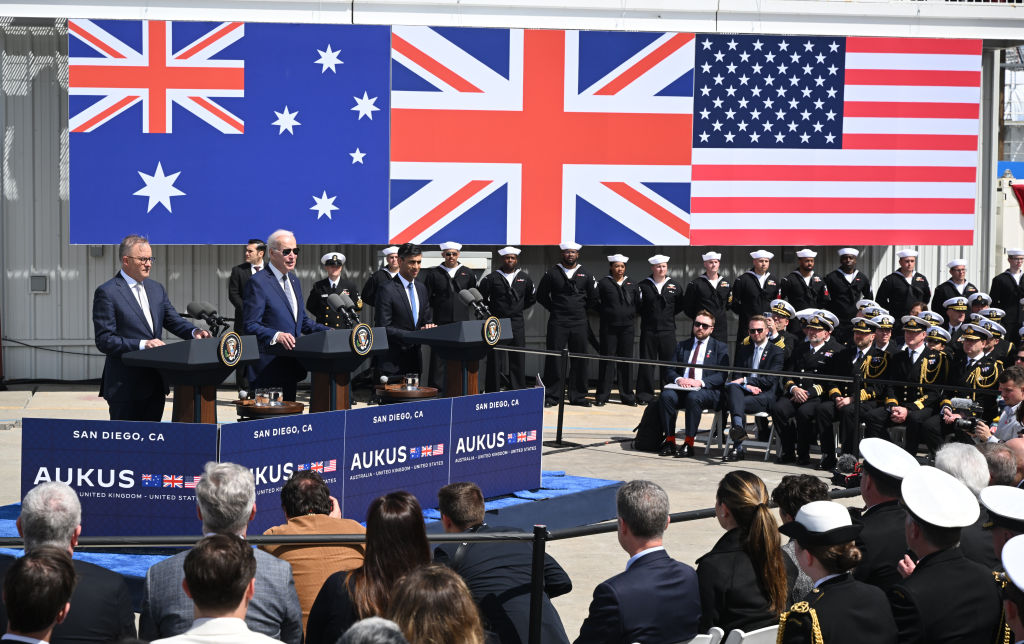
We’re at an important inflection point on the AUKUS timeline.
Now that a roadmap for Australia’s acquisition of nuclear-powered submarines is in place under the banner of AUKUS Pillar 1, all three members are turning greater attention to building out Pillar 2 and its focus on advanced capabilities and technologies.
To be sure, the AUKUS partners have yet to demonstrate proof of concept for Pillar 2. But at the very least, the testing of an AUKUS artificial intelligence and autonomy capability in the United Kingdom in April certainly demonstrated proof of life in the Pillar 2 enterprise.
It’s through these sorts of projects that Australia’s latent technological advantages can come into their own. After all, Pillar 2 isn’t simply about accessing US technologies, though that’s certainly part of the appeal. It’s also about Australia making valuable—and valued—contributions to developing the capabilities that will help the AUKUS partners achieve shared objectives in the Indo-Pacific.
For Pillar 2 to truly succeed, Australia will need as much faith in the capacity of our AUKUS partners to safeguard our advantages as they will need in us to do the same. In other words, the three countries need to think creatively about how they will protect their shared advantages, not just how they will develop them, as part of the partnership’s greater architecture.
Evidence suggests that this is where the conversation is headed. Testimony from two senior White House officials before the US House Foreign Affairs Committee last month indicated that discussions about the requirements for a fully functioning AUKUS are evolving in the right direction.
The hearing in question ostensibly focused on ‘modernising US arms exports for a stronger AUKUS’, an issue of critical importance to Australia—and the subject of a major report published by the United States Studies Centre that I coauthored with William Greenwalt, titled Breaking the barriers. On this, there were encouraging signs of progress. Assistant Secretary of Defense for Strategies, Plans and Capabilities Mara Karlin and Assistant Secretary of State for Political-Military Affairs Jessica Lewis both outlined how Washington intends to modernise and streamline export control regimes for AUKUS countries.
As Karlin said, ‘This historic opportunity requires historic change.’
Importantly, however, the hearing raised other questions about how the three countries will protect their military-technological advantages from prying eyes and ears.
On this issue, Lewis said that the US would also seek commitments from Australia and Britain ‘on shared standards for the protection of defense information and materials’ consistent with US regulations. Doing so, she claimed, would ensure that US export control standards ‘serve as a shield for our trilateral defence technological advantage’.
Kickstarting the discussion about how the AUKUS partners will protect their shared defence technology advantages is a good move. It will help to set the conditions for seamless collaboration on advanced military capabilities in the long term. After all, that’s what AUKUS requires: rethinking the way in which Australia, the UK and the US cooperate on defence industry and technology.
But for Australia, the solution is not a wholesale adoption of the American model. To truly reflect the spirit of AUKUS, the partners need a genuinely trilateral approach to developing common procedures and protections for shared advantages.
This will be essential for establishing a mutually trusted community of commercial and defence companies to help deliver AUKUS projects. The current approach—where the three countries adjudicate the trustworthiness of these entities independently—is not fit for that purpose and will create problems down the line if left untouched.
Addressing these requirements trilaterally will also put to bed the perennial trust issues that have shadowed AUKUS since its inception.
Australians might have assumed that our Five Eyes membership and already-intimate defence relationship with America would make sharing information and technology through AUKUS Pillar 2 relatively easy.
In reality, things haven’t been that simple. In private, US interlocutors have increasingly voiced reservations around the integrity of Australian and UK information and technology protections. But until recently, those concerns were rarely articulated with the detail or specificity that would help Australia to understand the issues, let alone address them.
That led many across the Australian defence landscape to consider the trust discussion a bit of a red herring.
This isn’t to say that Australia doesn’t have work to do. Yes, there’s a good news story to tell about measures already taken in areas like foreign interference and investment screening. Yet as the AUKUS partners gear up to deliver Pillars 1 and 2, Australia will likely need to consider further reforms to things like workforce vetting procedures, digital platform security and security clearance checks.
At the same time, these reforms won’t always mirror US practices and procedures. Australia’s painful experience with US export controls is a good example of why simply bringing allies ‘up to speed’ with American technology protections isn’t always the optimal solution.
What’s more, allies could point to the leakiness of Washington’s own defence technology ecosystem as grounds for their own concerns. Reporting in October 2022 revealed that front companies connected to the Chinese military had harvested troves of US software products with potential military applications. Evidence suggests that some of these products supported China’s October 2021 hypersonic missile test, dubbed a ‘Sputnik moment’ by US Chairman of the Joint Chiefs of Staff Mark Milley.
But this isn’t about pointing fingers; it’s about underscoring the requirement for a truly collaborative approach to developing technology protections that incorporate the preferences and best practices of all three countries. The mutual trust and spirit of collaboration that AUKUS is supposed to reflect will only be realised if all three partners contribute to setting the terms for new forms of cooperation. A genuinely trilateral approach to developing AUKUS-grade technology protections is the best way to foster—and to keep—that trust.

